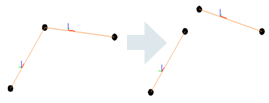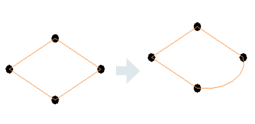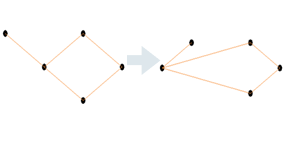在分析塑型的環境中探索新開發的 API。
此專案是 Revit 更廣泛的「分析驅動塑型」計畫的一部分,此計畫對分析塑型引入一個創新的方法,以增強其整體結構塑型功能。分析模型是 BIM 資料的重要部分,受工程團隊內及各專案團隊間協同合作工作流程的規範,因此,Revit 的新功能和行為讓工程師能夠:
- 自由地進行分析塑型,以反映出他們與結構元素和被視為完整系統的建築/結構相關的個人設計決策。
- 以分析方式表示任何類型的結構。
- 建立一致的分析模型,以便從 Revit 模型進行結構分析工作。
- 使用分析軟體執行完整的雙向工作流程,並擷取在其中所做的模型修改。
- 在需要時保留分析模型,以避免意外的變更。
- 建立多個反映不同分析類型和規劃的分析模型。
- 複製如同專用結構分析軟體中進行分析塑型的簡易性,並結合具備 BIM 平台之參數式和協同合作的強大功能。
具有新 API 的 Revit 元素
新的 API 類別
AnalyticalElement - 代表所有分析物件的基礎類別。取代了 AnalyticalModel。
-
Transform GetTransform () - Returns the transform which reflects Analytical Element orientation.
-
AnalyzeAs AnalyzeAs - This represents the Analyze As parameter assigned to Analytical Element.
-
Reference GetReference (AnalyticalModelSelector selector) - Returns a reference to a given curve within the Analytical Element.
-
ElementId MaterialId - Defines the Material Id for the Analytical Element.
AnalyticalMember - 代表結構分析模型中的線性元素。取代了 AnalyticalModelStick 和 AnalyticalModelColumn。
-
AnalyticalMember Create(Document aDoc,Curve curve) - Method which creates a new instance of an Analytical Member within the project.
-
AnalyticalStructuralRole StructuralRole - The structural role assigned to the Analytical Member.
-
Curve GetCurve () - Returns the curve of the Analytical Member.
-
void SetCurve(Curve curve) - Sets the curve for the Analytical Member. This method disconnects elements from other analytical elements (if the end nodes are in the same position).

If the user wants to move the corner, and keep the connection, there are other ways for achieving that such as ElementTransformUtils.moveElements.
-
bool IsValidCurve(Curve curve) - Verifies if the curve is valid for an Analytical Member.
-
void FlipCurve() - Flips the ends of the Analytical Member.
-
StructuralSectionShape StructuralSectionShape - The structural section shape of the Analytical Member (read only).
-
ElementId SectionType - The id of the type from the structural family assigned to the Analytical Member.
-
double CrossSectionRotation - Cross-section rotation of the Analytical Member.
AnalyticalPanel - 代表結構分析模型中的表面。取代了 AnalyticalModelSurface。
-
AnalyticalPanel Create(Document aDoc, CurveLoop curveLoop) - Method which creates a new instance of an Analytical Panel within the project.
-
CurveLoop GetOuterContour() - Returns the Curve Loop that defines the geometry of the Analytical Surface element.
-
bool IsCurveLoopValid(CurveLoop profile) - Checks if curve loop is valid for Analytical Panel.
- 若要修改「分析嵌板」幾何圖形,使用者應使用 SketchEditScope 架構。此功能已使用新方法增強:
-
void StartWithNewSketch(ElementId elementId) - Starts a sketch edit mode for an element which, at this moment, doesn't have a sketch.
-
- 編輯幾何圖形的另一種方式是:
-
void SetOuterContour(CurveLoop outerContour) - Sets the Curve Loop that defines the geometry of the Analytical Surface element.

-
與 AnalyticalMember 類似,設定分析嵌板的輪廓線會切斷與其他分析元素的連接。如果使用者要移動轉角並保持連接,還有其他方法可以達成,例如 ElementTransformUtils.moveElements。
-
- 若要修改「分析嵌板」幾何圖形,使用者應使用 SketchEditScope 架構。此功能已使用新方法增強:
-
ISet<ElementId> GetAnalyticalOpeningsIds() - Returns the Analytical Openings Ids of the Analytical Panel.
-
ElementId SketchId - Sketch associated to this Revit element.
-
AnalyticalStructuralRole StructuralRole - Structural role assigned to the Analytical Panel.
AnalyticalOpening - 代表「分析嵌板」中開口的元素。這是 Revit API 中的新物件 (在此版本之前,分析開口沒有單獨的元素)。
-
AnalyticalOpening Create(Document doc, CurveLoop curveLoop, ElementId panelId) - Method which creates a new instance of an Analytical Opening within the project.
-
CurveLoop GetOuterContour () - Returns the Curve Loop that defines the geometry of the Analytical Surface element.
-
bool IsCurveLoopValidForAnalyticalOpening(CurveLoop loop, Document aDoc, ElementId panelId) - Checks if curve loop is valid for Analytical Opening.
- 若要修改「分析開口」幾何圖形,請使用 SketchEditScope 架構。
- 修改「分析開口」幾何圖形的另一種方式是:
-
void SetOuterContour(CurveLoop outerContour) - Sets the Curve Loop that defines the geometry of the Analytical Surface element.
-
-
ElementId PanelId - ElementId of the host Analytical Panel.
-
ElementId SketchId - Sketch associated to this Revit element.
AnalyticalToPhysicalAssociationManager - 管理分析元素與實體元素之間的關聯。先前,元素本身彼此互相了解,使用者無法控制元素 (無法修改關聯)。使用此新方法可以編輯關聯。支援 1 對 1 關聯,元素不能同時是多個關聯的一部分。
-
AnalyticalToPhysicalAssociationManager GetAnalyticalToPhysicalAssociationManager(Document doc) Returns the AnalyticalToPhysicalAssociationManager for this document.
-
void AddAssociation(ElementId analyticalElementId, ElementId physicalElementId) - Adds a new association between an analytical element and a physical element.
-
void RemoveAssociation(ElementId elementId) - This method will remove the association for the element with the given ElementId.
-
ElementId GetAssociatedElementId (ElementId elementId) - Returns id of the element which is associated with the given ElementId.
-
bool HasAssociation(ElementId id) - Verifies if the element has already defined an association.
AnalyticalNodeData - 保留分析節點連接狀態的相關資訊。
-
AnalyticalNodeData GetAnalyticalNodeData ( Element element) - Returns AnalyticalNodeData associated with this element, if it exists.
-
AnalyticalNodeConnectionStatus GetConnectionStatus () - Returns the Connections Status for an Analytical Node.
AnalyticalLink、BoundaryCondition 和 Load 已移轉為與新元素搭配運作。在大多數情況下,與它們相關的 API 會保持不變。Load 已做了一些增強。
Load
-
LineLoad.Create(Document aDoc,ElementId hostElemId, XYZ forceVector1, XYZmomentVector1, LineLoadType symbol).
-
LineLoad.Create(Document aDoc,ElementId hostElemId, int curveIndex, XYZ forceVector1, XYZ momentVector1, Structure.LineLoadType symbol).
-
LineLoad.IsValidHostId(Document doc, ElementId hostElemId).
-
AreaLoad.IsValidHostId(Document doc, ElementId hostElemId).
-
AreaLoad.Create(Document doc, ElementId hostElemId, XYZ forceVector1, AreaLoadType symbol).
-
PointLoad.Create(Document doc, ElementId hostElemId, AnalyticalElementSelector selector, XYZ forceVector, XYZ momentVector, AreaLoadTyp symbol).
-
PointLoad.IsValidHostId(Document doc, ElementId hostElemId).
範例
建立分析構件
using (Transaction transaction = new Transaction(document, "Create Analytical Member"))
{
transaction.Start();
//create curve which will be assigned to the analytical member
Line line = Line.CreateBound(new XYZ(0, 0, 0), new XYZ(5, 0, 0));
//create the AnalyticalMember
AnalyticalMember analyticalMember = AnalyticalMember.Create(document, line);
analyticalMember.StructuralRole = AnalyticalStructuralRole.StructuralRoleBeam;
transaction.Commit();
}
建立分析嵌板
using (Transaction transaction = new Transaction(revitDoc, "Create Analytical Panel"))
{
transaction.Start();
//create the curveLoop for the AnalyticalPanel element
CurveLoop profileloop = new CurveLoop();
profileloop.Append(Line.CreateBound(new XYZ(1, 1, 0), new XYZ(2, 1, 0)));
profileloop.Append(Line.CreateBound(new XYZ(2, 1, 0), new XYZ(2, 2, 0)));
profileloop.Append(Line.CreateBound(new XYZ(2, 2, 0), new XYZ(1, 2, 0)));
profileloop.Append(Line.CreateBound(new XYZ(1, 2, 0), new XYZ(1, 1, 0)));
//create the AnalyticalPanel
analyticalPanel = AnalyticalPanel .Create(revitDoc, profileloop);
transaction.Commit();
}
在實體元素與分析元素之間加入新關聯
using (Transaction trans = new Transaction(doc, "AddAssociationBetweenPhysicalAndAnalyticalElements"))
{
trans.Start();
ElementId analyticalElementId = ContextualAnalyticalModel.Utilities.GetSelectedObject(activeDoc, "Please select analytical element");
ElementId physicalElementId = ContextualAnalyticalModel.Utilities.GetSelectedObject(activeDoc, "Please select physical element");
//gets the AnalyticalToPhysicalAssociationManager for the current document
AnalyticalToPhysicalAssociationManager analyticalToPhysicalManager = AnalyticalToPhysicalAssociationManager.GetAnalyticalToPhysicalAssociationManager(doc);
if (analyticalToPhysicalManager == null)
return Result.Failed;
//creates a new association between physical and analytical elements
analyticalToPhysicalManager.AddAssociation(analyticalElementId, physicalElementId);
trans.Commit();
}
使用 SketchEditScope 架構編輯分析嵌板的邊界

// Start a sketch edit scope
SketchEditScope sketchEditScope = new SketchEditScope(document, "Replace line with an arc");
sketchEditScope.StartWithNewSketch(analyticalPanel.Id);
using (Transaction transaction = new Transaction(document, "Modify sketch"))
{
transaction.Start();
//replace a boundary line with an arc
Line line = null;
Sketch sketch = document.GetElement(analyticalPanel.SketchId) as Sketch;
if (sketch != null)
{
//find first line in the sketch profile
…..
}
// Create arc
XYZ normal = line.Direction.CrossProduct(XYZ.BasisZ).Normalize().Negate();
XYZ middle = line.GetEndPoint(0).Add(line.Direction.Multiply(line.Length / 2));
Curve arc = Arc.Create(line.GetEndPoint(0), line.GetEndPoint(1), middle.Add(normal.Multiply(20)));
// Remove element referenced by the found line.
document.Delete(line.Reference.ElementId);
// Model curve creation automatically puts the curve into the sketch, if sketch edit scope is running.
document.Create.NewModelCurve(arc, sketch.SketchPlane);
transaction.Commit();
}
sketchEditScope.Commit(new FailurePreproccessor());
移動分析節點並保持連接

// Create Analytical Panel
AnalyticalPanel analyticalPanel = CreateAnalyticalPanel.CreateAMPanel(document);
// Create the connected Analytical Member
AnalyticalMember analyticalMember = CreateAnalyticalMember.CreateMember(document);
// Select the node
Reference eRef = activeDoc.Selection.PickObject(ObjectType.PointOnElement , "Select an Analytical Node");
// Move the Analytical Node using ElementTransformUtils
using (Transaction transaction = new Transaction(document, "Move node with ElementTransformUtils"))
{
transaction.Start();
ElementTransformUtils.MoveElement(document, eRef.ElementId, new XYZ(-5, -5, 0));
transaction.Commit();
}
取得分析表面輪廓線點
使用先前的解決方案:
private List<XYZ> GetSurfaceContourPoints( Document doc, ElementId elementId )
{
// Create point list, get list of curves from analytical model
List<XYZ> contourPoints = new List<XYZ>();
AnalyticalModel analyticalModel = (doc.GetElement(elementId) as AnalyticalModel);
IList<Curve> curves = analyticalModel.GetCurves(AnalyticalCurveType.RawCurves);
// Iterate over curves and make the desired processing
…...
return contourPoints;
}
使用新的解決方案:
private List<XYZ> GetSurfaceContourPoints( Document doc, ElementId elementId )
{
// Create point list, get list of curves from analytical model
List<XYZ> contourPoints = new List<XYZ>();
AnalyticalPanel analyticalPanel = (doc.GetElement(elementId) as AnalyticalPanel);
CurveLoop outerContour = analyticalPanel.GetOuterContour();
// Iterate over curves and make the desired processing
…...
return contourPoints;
}
為實體分析元素取得關聯的分析元素
AnalyticalElement GetAnalyticalElement(Element physicalElement)
{
AnalyticalElement analyticalElement = null;
Document document = element.Document;
AnalyticalToPhysicalAssociationManager assocManager = AnalyticalToPhysicalAssociationManager.GetAnalyticalToPhysicalAssociationManager(document);
if (assocManager != null)
{
ElementId associatedElementId = assocManager.GetAssociatedElementId(physicalElement.Id);
if (associatedElementId != ElementId.InvalidElementId)
{
Element associatedElement = document.GetElement(associatedElementId);
if (associatedElement != null && associatedElement is AnalyticalElement)
{
analyticalElement = associatedElement as AnalyticalElement;
}
}
}
return analyticalElement;
}
建立線邊界條件
使用先前的解決方案:
private BoundaryConditions CreateLineBC(Element hostElement)
{
Document createDoc = hostElement.Document.Create;
// use Document.NewLineBoundaryConditions Method
BoundaryConditions createdBC =
createDoc.NewLineBoundaryConditions(hostElement.GetAnalyticalModel(), 0, 0, 0, 0, 0, 0, 0, 0);
return createdBC;
}
使用新的解決方案:
private BoundaryConditions CreateLineBC(Element hostElement)
{
Document createDoc = hostElement.Document.Create;
// use Document.NewLineBoundaryConditions Method
AnalyticalElement analyticalElement = GetAnalyticalElement(hostElement);
BoundaryConditions createdBC =
createDoc.NewLineBoundaryConditions(analyticalElement, 0, 0, 0, 0, 0, 0, 0, 0);
return createdBC;
}